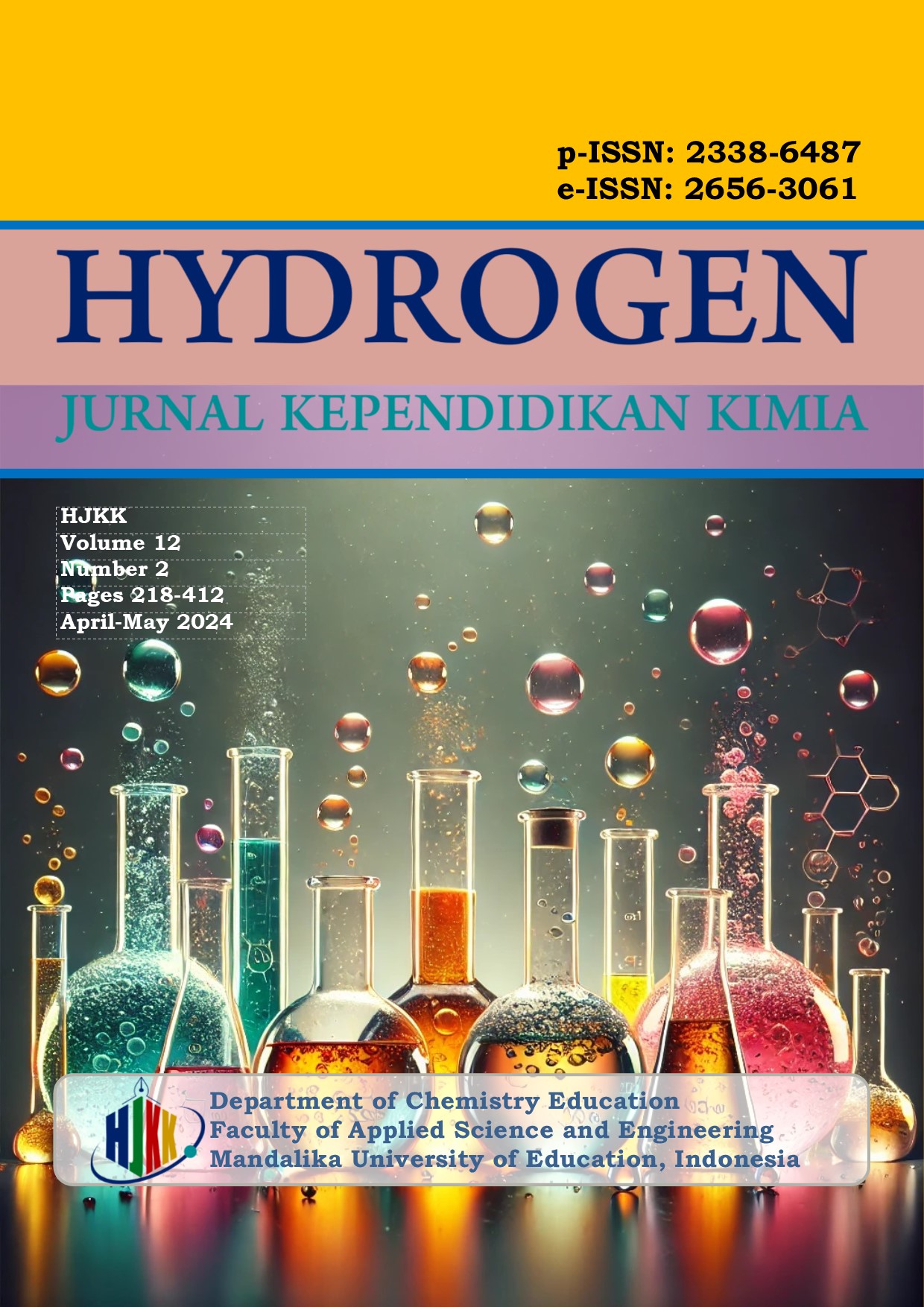Description of Students' Science Literacy Ability on Electrolyte and Non-Electrolyte Solution Materials at SMAN 11 Pontianak
DOI:
https://doi.org/10.33394/hjkk.v12i2.10176Keywords:
description, electrolytes and non-electrolytes, scientific literacy.Abstract
References
Abduloh, U., Karomah, N., & Hidayati, S. (2018). Peningkatan kemampuan pemecahan masalah matematika dalam Soal literasi matematika melalui model creative problem solving kelas VIII H SMPN 9 Semarang. PRISMA, Prosiding seminar nasional matematika, 1, 774–780.
Afriana, J., Permanasari, A., & Fitriani, A. (2016). Penerapan project based learning terintegrasi STEM untuk meningkatkan literasi sains siswa ditinjau dari gender. Jurnal Inovasi Pendidikan IPA, 2(2), 202. https://doi.org/10.21831/jipi.v2i2.8561
Anjarsari, P. (2014). Literasi Sains Dalam Kurikulum Dan Pembelajaran Ipa Smp. Prosiding Semnas Pensa VI â€Peran Literasi Sainsâ€.
Azizah Arisman, A. P. (2015). Penerapan Pembelajaran Kooperatif Tipe Stad Dengan Metode Praktikum Dan Demonstrasi Multimedia Interaktif (Mmi) Dalam Pembelajaran Ipa Terpadu Untuk Meningkatkan Literasi Sains Siswa. Edusains, 7(2), 179–184.
Dewi, R., Titin Supriyanti, F. M., & Dwiyanti, G. (2016). Analisis Penguasaan Konsep Larutan Elektrolit-Nonelektrolit Siswa Menggunakan Siklus Belajar Hipotesis Deduktif. Jurnal Kimia dan Pendidikan, 1(2), 1–12.
Diana, S., Rachmatulloh, A., & Rahmawati, E. S. (2015). Profil Kemampuan Literasi Sains Siswa SMA Berdasarkan Instrumen Scientific Literacy Assesments ( SLA ) High School Students ’ Scientific Literacy Profile Based on Scientific Literacy Assessments ( SLA ) Instruments. Seminar Nasional XII Pendidikan Biologi 2015 FKIP UNS, 285–291.
Fitriani, W., Hairida, & Lestari, I. (2014). Deskripsi Literasi Sains Siswa Dalam Model Inkuiri Pada Materi Laju Reaksi Di Sman 9 Pontianak. Jurnal Pendidikan dan Pembelajaran, 3 (1), 12.
Nisrina, N., Jufri, A. W., & Gunawan, G. (2020). Pengembangan LKPD Berbasis Blended Learning untuk Meningkatkan Literasi Sains Peserta Didik. Jurnal Pijar Mipa, 15(3), 192–199. https://doi.org/10.29303/jpm.v15i3.1880
Nur Hasan, E., Rusilowati, A., & Astuti, B. (2018). Analysis of Students Science Literacy Skills in Full Day Junior High School Article Info. Budi Astuti / JISE, 7(2), 237–244.
Odja, A. H., & Payu, C. S. (2014). Analisis-Kemampuan-Awal-Literasi-Sains-Siswa-Pada-Konsep-IPA.pdf. Jurusan Kimia FMIPA Universitas Negeri Surabaya.
OECD. (2019a). PISA 2018 Assessment and Analytical Framework, PISA. In OECD Publishing. OECD Pubhlishing. https://doiorg/10.1787/b25efab8-en
OECD. (2022). PISA 2022 Results (Volume I): The State of Learning and Equity in Education. OECD Pubhlishing, Paris. https://doi.org/10.1787/53f23881-en.
Pratiwi, S. N., Cari, C., & Aminah, N. S. (2019). Pembelajaran IPA Abad 21 dengan Literasi Sains Siswa. Jurnal Materi dan Pembelajaran Fisika, 9, 34–42.
Ridani, M. (2021). Profil Kemampuan Literasi Sains Siswa MAN 2 Ngawi pada Materi Hukum Dasar Kimia.Undergraduate (S1) Thesis, Universitas Islam Indonesia Walisongo Semarang.
Rohmaya, N., Sudiatmika, A. A. I. A. R., & Subagia, I. W. (2022). Deskripsi Kemampuan Awal Literasi Sains Siswa Kelas XI IPA MAN Buleleng Pada Topik Kimia Hijau. Jurnal Penelitian Pendidikan Kimia: Kajian Hasil Penelitian Pendidikan Kimia, 9(1), 28–41. https://doi.org/10.36706/jppk.v9i1.16929
Shwartz, Y., Ben-Zvi, R., & Hofstein, A. (2006). The use of scientific literacy taxonomy for assessing the development of chemical literacy among high-school students. Chemistry Education Research and Practice, 7(4), 203–225. https://doi.org/10.1039/B6RP90011A
Yusuf, S. (2003). Literasi Sains Siswa Indonesia Laporan PISA 2003. Jakarta : Pusat Penelitian Pendidikan. Tersedia di : http://www.p4tkipa.org.
Downloads
Published
How to Cite
Issue
Section
Citation Check
License
License and Publishing Agreement
In submitting the manuscript to the journal, the authors certify that:
- They are authorized by their co-authors to enter into these arrangements.
- The work described has not been formally published before, except in the form of an abstract or as part of a published lecture, review, thesis, or overlay journal.
- That it is not under consideration for publication elsewhere,
- That its publication has been approved by all the author(s) and by the responsible authorities – tacitly or explicitly – of the institutes where the work has been carried out.
- They secure the right to reproduce any material that has already been published or copyrighted elsewhere.
- They agree to the following license and publishing agreement.
Copyright
Authors who publish with Hydrogen: Jurnal Kependidikan Kimia agree to the following terms:
- Authors retain copyright and grant the journal right of first publication with the work simultaneously licensed under a Creative Commons Attribution License (CC BY-SA 4.0) that allows others to share the work with an acknowledgment of the work's authorship and initial publication in this journal.Â
- Authors are able to enter into separate, additional contractual arrangements for the non-exclusive distribution of the journal's published version of the work (e.g., post it to an institutional repository or publish it in a book), with an acknowledgment of its initial publication in this journal.
- Authors are permitted and encouraged to post their work online (e.g., in institutional repositories or on their website) prior to and during the submission process, as it can lead to productive exchanges, as well as earlier and greater citation of published work.
Licensing for Data Publication
Hydrogen: Jurnal Kependidikan Kimia uses a variety of waivers and licenses, that are specifically designed for and appropriate for the treatment of data: Open Data Commons Attribution License, http://www.opendatacommons.org/licenses/by/1.0/ (default) Other data publishing licenses may be allowed as exceptions (subject to approval by the editor on a case-by-case basis) and should be justified with a written statement from the author, which will be published with the article.







